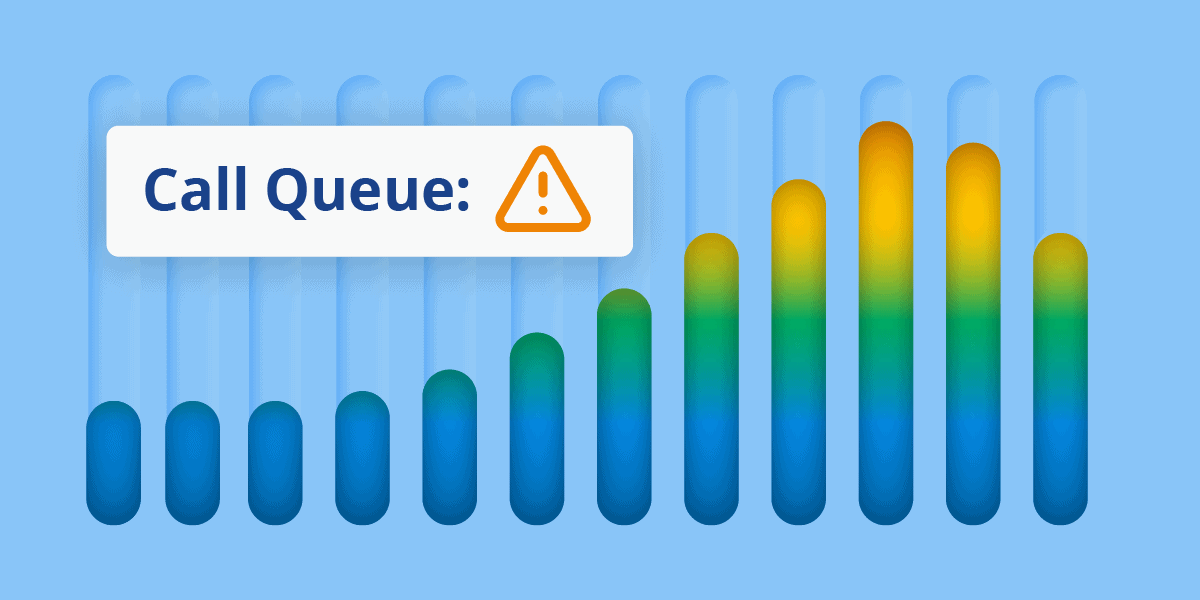How to Manage Your Call Queues During Volume Spikes

People expect high-quality and positive customer service experiences in exchange for spending their hard-earned dollars with your company.
Yet, long hold times are still a common experience for many customers. As a contact center leader, call queue management can be an ongoing battle. But it’s an important one to fight. 58% of customers have no problem cutting ties with a brand due to poor customer service. This means that ensuring your call center queue system is streamlined should be a top priority.
How do you achieve this level of top-notch customer service? We have compiled seven tips that can increase your ability to handle incoming calls.
Seven Call Queue Management Tips
1. Understand Why Call Volume is High
Before you can address your call center queue software needs and clear the queues, you must understand the root cause: Why is your call volume so high?
Inbound call volume spikes may be caused by:
- Macro Events that are typically long-term, large at scale, and significant to your business. Events like weather disasters, power outages, and uncommon situations may cause a surge in customer inquiries.
- Micro Events & Non-Events: Micro events are more common, trivial situations that may not have as big of an impact on your business as macro events. Think of campaigns, contract renewals, or any other smaller but expected business situations that may cause higher-than-normal call levels. And then there are non-events, stuff that wasn’t planned but can cause high call volumes, such as inaccurate customer journeys in the IVR, invoice/account process mistakes, or lack of self-service resources for agents.
Once you understand why your call volume is so high, you can learn how to manage call center queues using cloud communications call routing features.
Call routing features
Cloud communications call routing features are a set of capabilities that allow businesses to route incoming calls to the most appropriate agents or departments based on predefined criteria. Common features for call queue management include:
- Skills-Based Routing (SBR): This customer service strategy assigns incoming calls to the most suitable agents tagged for handling a specific situation.
- Priority Routing: This feature assigns the next caller to speak with an available agent based on predetermined priority or VIP tags.
- Custom Ring Strategies: Forward inbound calls using round-robin, least-used, and more to reduce queue load.
- Interactive Voice Response: This feature allows you to personalize menu navigation to your customers’ needs.
- Automatic Call Distribution: This feature is your customer experience engine, connecting callers to an agent the first time.
These call routing features also help streamline agent production and eliminate silos using webhooks to pull CRM data. This allows agents to get insights on the next caller so they can better assist them. Plus, they can leave notes for the next agent.
2. Stack Agent Coverage
Stacking agent coverage during high call volume times can help clear your call center queues. As Greg Buckalew, SVP Operations, AVOXI mentions in our recent webinar addressing contact center call spikes, consider the “follow the sun” technique for agent stacking. This workflow strategy involves increasing global agent coverage in the call center queues as they work their normal day shifts in their timezone.
The “follow the sun” strategy helps keep call queue management in check by…
- Increasing agent responsiveness
- Reducing answer delays
- Improving customer experiences
The more agent hands you have on deck in the queue, the more calls will be answered— and more customer issues will be solved. Plus, you can’t forget just how important agent stacking is to improving agent job satisfaction as well.
“As colleagues have a bit of a breath between calls, they tend to turn over less and our attrition rates actually improve.”
- Brian Stoner, AVP Global Performance & Planning, Hyatt
3. Incentivizing
When your agents are happy, they’re more likely to keep your customers happy too. But it’s easy for your agents to become flustered during call volume spikes. One way you can keep your contact center agents happy while managing call queue coverage is by offering incentives during periods of high call volumes. Here are three ways you can successfully do this:
- Overtime: Provide an increase in pay for taking on extra shifts at crucial call times.
- Flexible Paid Time Off (PTO): Give extra time off when it’s convenient for that agent’s personal needs.
- Offer Voluntary Time Off (VTO): Provide VTO as an unpaid benefit to motivate agents to work during peak busy call seasons and take other days off as desired.
Never underestimate the power of shift flexibility. Agents are often willing to adjust or add to their work schedules in times of business need, especially if they feel their work is being acknowledged. Incentives are a great way to tell them you appreciate them.
4. Prepare Agents with Routine Training
Preparation is vital to ensure agents provide the best customer experience possible.
As Greg Buckalew mentions in the webinar, AVOXI focuses on training agents in a collaborative environment to provide higher-quality customer experiences.
“We try to avoid using scripts— We want them to listen to the customers and not worry about a script. This leads to organic conversations that are fluid.”
- Greg Buckalew, SVP of Operations, AVOXI
Routine call center queue system training should include collaborative efforts for best results. These efforts may include role-playing, holding team meetings, and completing group activities as a team to build trust and confidence in your agents’ conversational skills.
Collaborative training with call center queue software
You may be asking yourself, “How do I know what skills to focus agent training on, and how often?”
A great place to answer these questions is by looking at the data. With cloud communications tools, you can track your call center analytics. You also have the ability to track service levels and predict customer behaviors to guide your call center queue system training efforts through features like…
- Call journey
- Live queue analytics
- Agent status reporting
- And more!
Through analysis of these analytics with your cloud communications technology platform, you’ll know exactly where agents may be lacking and in need of extra call queue management training.
5. Offer a Callback Option
If you’ve ever called a contact center, you know just how frustrating it can be to wait on hold. Research shows the duration of hold time significantly impacts the emotional state of customers, with 44% of people reporting feelings of annoyance, irritation, or anger after waiting for 5 to 15 minutes. What’s worse is that there’s typically little to no indication of how long it will take, disrupting your whole day.
Call center queue software offers you a feature to call back customers upon agent availability and improves the customer experience by:
- Giving callers back time in their day that would have been spent on hold
- Providing agents the ability to prepare, focus and make the call a positive experience for both parties
Keep in mind that backed up queues don’t just leave your customers feeling frustrated– it can leave your agents feeling underwater as well.
When your agents feel more prepared to respond, they perform their job duties better and with more confidence. By following the tips above, you can help your agents manage an influx of call volume while improving your KPIs and enhancing customer service along the way.
6. Create a Self-Service Knowledge Base
When calls are flooding in, it’s important to protect your agents’ time by letting callers know what’s happening. Then, they can decide the best course of action: continue waiting in the call center queue system for the next agent or select a self-service option.
The key here is offering your customers options! With cloud communications, you can easily offer a self-service knowledge base. Documents in the database may help callers:
- Avoid wait times
- Get the answers they need
- Solve their issues quicker
How can you inform customers of this self-service knowledge base?
Of course, self-service knowledge bases can only be successful if your customers know they exist and how to access them.
As mentioned in our webinar, partnering with a cloud call queue solutions partner to implement front-loading automated messages in times of high call volumes can help you achieve this.
When callers understand their self-service options and act upon other channels, it reduces the number of calls coming in, resulting in clear call queues, improved KPIs, happier customers, and less stressed agents.
7. Open More Support Channels
If you don’t have the resources available for self-service options, giving your customers other support channels can significantly reduce the number of incoming calls at one time.
Consider using call queue management technology to support other direct channels such as:
- Live agent chats
- Automated chatbots
- Slack/collaboration tools
- Social media
These options are accessible, convenient alternatives to calling a contact center and waiting on hold for long time periods.
Remember, your callers appreciate having options to take and are more likely to have a positive customer experience.
Improve Call Queue Management with Call Center Queue Software
High call volume queues can have business effects such as negative customer service and poor agent job satisfaction. If your contact center call queues are spiking, it may lead to both scenarios— but don’t panic!
Following the seven tips above for call queue management with cloud communications technology like the AVOXI Platform, which can help you clear out your contact center call queues, leading to happier agents and customers.
To learn other tips and tricks for managing your call center, watch our on-demand webinar Call Volume Spikes in Your Contact Center: How to Go from Surviving to Thriving.
On-Demand Webinar
Call Volume Spikes in Your Contact Center: How to Go from Surviving to Thriving
Learn just how Hyatt and AVOXI are managing high call volume in their call centers every day.

